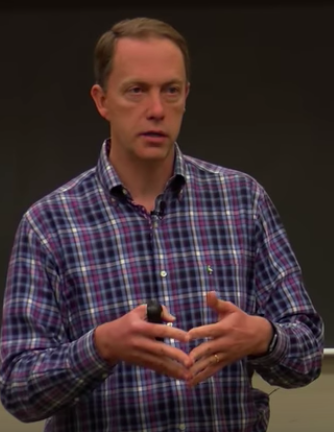News | Dr. Gary Painter and Madison Swayne Dive Into an Innovative Approach to Using GTFS Data
Stop the VideoNews

METRANS UTC
Dr. Gary Painter and Madison Swayne Dive Into an Innovative Approach to Using GTFS Data
Sunday, February 10, 2019
by By: Maria Hsin
January 30, 2019, Dr. Gary Painter and Madison Swayne presented their research, Innovation on Job Accessibility with General Transit Feed Specification (GTFS) Data at USC, their new research regarding job accessibility via public transit to nearly 100 students, faculty, researchers, practitioners and community members as part of the METRANS spring speaker series. For those unfamiliar with their work, Painter is a USC Sol Price School of Public Policy professor and director of the Sol Price Center for Social Innovation, and Swayne is a Ph.D. candidate in Urban Planning and Development at the Sol Price School.
I was excited to join the seminar as transportation is a topic of great interest to me; I often use public transit, and almost five years ago, gave up my car for a scooter (a Vespa-like scooter, not the Bird/e-scooter variety). My experience has shown me that some areas of Los Angeles County are much easier to access than others via public transit. And while bus service around Los Angeles has improved, I do remember being stranded on an empty stretch of Jefferson Boulevard, before Playa Vista existed, wondering if I had misread the schedule or if the bus simply failed to show. During my days as a journalist, when my car was in the shop for repairs, I commuted to my Glendale office from Inglewood by bus, a challenging experience I would not wish to repeat.
Painter and Swayne seem to have discovered a similar reality with their research. They note the increasing commute times as people locate further away from their employment, and also touched on issues of equity and point to important literature on employment, job growth, housing and accessibility.

Interestingly, the notion for studying transit accessibility and employment was sparked by Year Up, a non-profit organization with offices in L.A., Chicago, San Francisco and Boston, and other locations. Year Up focuses on connecting jobs to populations, specifically those in high poverty tracts, Painter shared. The organization was looking for assistance in pairing young adults ages 18 to 24 who are in school but not employed, also referred to as “Opportunity Youth.”
The nonprofit, partnering with the IT sector and health firms, takes students trained at community colleges and links them to jobs with their partners, but Year Up wanted to take it a step further and do whatever possible to ensure these new employees could successfully navigate public transit to their jobs.
For the study, Painter said they needed to measure opportunity and transit accessibility to understand the environment in which a person lives. Most prior studies had not focused on public transit as a primary access measure, he added.
General Transit Feed Specification data (GTFS), is the technology behind what powers the Google Maps app. Using this technology, Painter and Swayne’s study examined access to jobs along three new transit lines: Expo Phase 2; the planned Vermont Bus Rapid Transit (BRT) line; and the Crenshaw/LAX line, now scheduled to open in fall 2020.
Swayne noted that while it was not surprising that adding a new transit line resulted in better access to jobs, the study was significant.
“The big takeaway, what’s really exciting here, is the fact that we are able to augment GTFS data with proposed improvements to the [transit] system,” Swayne said. “And what we can actually do with some of this data, is if Metro is deciding between two alignments…we could plot both, and look at…which one is going to give us better improvements for jobs, or whatever else [it is] trying to giving people access to.”
The presentation may be viewed at:
https://www.youtube.com/watch?v=6eiXZkGY08c&feature=youtu.be
About the author:
Maria Hsin is a Los Angeles native and member of the inaugural online Executive Master of Urban Planning cohort in the USC Sol Price School of Public Policy. Ms. Hsin is also a writer and journalist, and her work appeared in the The Orange County Register, Los Angeles Times, and Proto magazine, among other media. She received a Bachelor’s degree in Sociology from St. Mary’s University in San Antonio, TX, after studying at the University of Notre Dame for two years.
News Archive
- December (1)
- November (6)
- October (4)
- September (2)
- August (3)
- July (4)
- June (3)
- May (7)
- April (8)
- March (11)
- February (8)
- January (7)
- December (7)
- November (8)
- October (11)
- September (11)
- August (4)
- July (10)
- June (9)
- May (2)
- April (12)
- March (8)
- February (7)
- January (11)
- December (11)
- November (5)
- October (16)
- September (7)
- August (5)
- July (13)
- June (5)
- May (5)
- April (7)
- March (5)
- February (3)
- January (4)
- December (4)
- November (5)
- October (5)
- September (4)
- August (4)
- July (6)
- June (8)
- May (4)
- April (6)
- March (6)
- February (7)
- January (7)
- December (8)
- November (8)
- October (8)
- September (15)
- August (5)
- July (6)
- June (7)
- May (5)
- April (8)
- March (7)
- February (10)
- January (12)















